|
Excelsior Park and the Jeanneret of St Imier
The name Jeanneret is associated with at least than 4 watchmaking companies of St Imier : Moeris, Léonidas, Excelsior Park and Jules-Fred. Jeanneret. In this article we will be interested in these two last entities and in particular in Excelsior Park.
Excelsior Park was a major company in the field of stopwatches and chronographs. Created in 1866, its origins are confused because two companies with close names and both installed in St-Imier assert the same creation date and same specialization in chronographs. It is about Jules-Fred. Jeanneret and Jeanneret and Fils. And to add to confusion the two companies used the same mark “Colombe” on certain watches. It seems well that the two companies had a common origin but they undoubtedly separated relatively early and then followed independent courses.
The Jules-Fred. Jeanneret branch
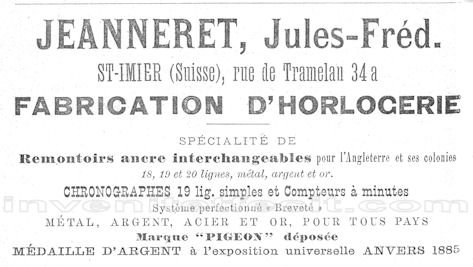
Advertisement of 1890
Jules-Fred. Jeanneret had its factory on Rue de Tramelan. In 1890 was produced anchor watches from 18 to 20 lines and 19 lines chronographs, with or without minutes counter. The trademark “Pigeon” was deposited and the company had obtained a silver medal at the World Fair of Antwerp in 1885.
Jules-Fred. Jeanneret dies with the beginning of the year 1890 and his wife took over the company which then takes the name of Vve of Jules-Fred. Jeanneret. Antimagnetic chronographs and chronographs with rattrapante, mechanism "en vue", make their appearance.

Advertisement of 1896
The chronographs were patented and an advertisement of 1896 teaches us that it is about the Swiss patent n° 359. This patent, deposited on March 18th 1889, relates to improvements brought to the construction of the chronograph and the inventor is Alfred Lugrin from L'Orient de l'Orbe, that one who is at the origin of the famous Lémania company. Alfred Lugrin had his own factory and it is possible that the two companies collaborated for the manufacture of the movements.
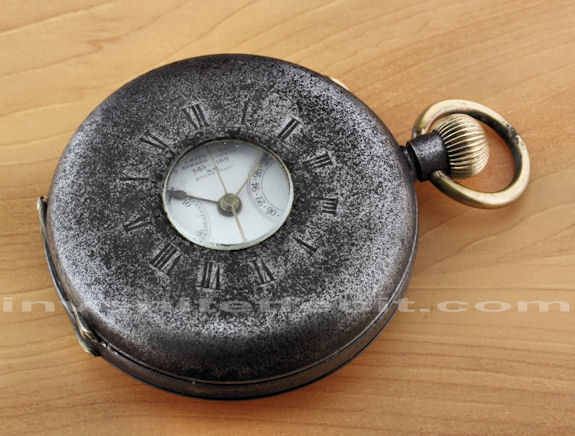


Chronograph with rattrapante from Smith & Son, c. 1895, Jules-Fred Jeanneret movement, Lugrin patent.
In 1900 appears the 13 lines chronograph, first step towards the wrist-chronograph. In 1901 the company becomes S. and P. Jeanneret, successor of Vve J. - F. Jeanneret, and little time after only remains the name Samuel Jeanneret.
In 1913 Samuel Jeanneret asserts the Colombe trademark and produces wrist-chronograph among the first available in Switzerland.
The company disappears for unknown reasons around 1925.
Excelsior Park and the Jeanneret and Fils branch

Advertisement of 1890
Jeanneret and Fils had created in Saint-Imier the Usine du Parc. In1890 the company is called Alb. Jeanneret et Frères and produces anchor watches from 13 to 24 lines, calendar watches and chronographs under the trademarks Colombe and Diana. The company also asserts a silver medal in Antwerp in 1885.
In 1894 the factory is called Jeanneret Frères and produces chronographs under the Colombe trademark and simple watches under the trademarks Diana and Cervin. A sport stopwatch, patented on March 21th 1891 by Alb. Jeanneret et Frères, is called “Excelsior”. It shows on the movement side a bridge in the shape of J which will become a trademark for Excelsior Park.

Patent of 1891 when one sees the bridge in the shape of J which will become the trademark of Excelsior Park
In 1902 the company becomes Jeanneret-Brehm, Usine du Parc, and produces its first 13 lines chronographs.
To supplement the range of watches, the H. Magnenat-Lecoultre factory in the Valley of Joux is purchased in 1911. This factory was specialized in the repeating watches, with or without chronograph. The company then takes the name of Jeanneret-Brehm and Co and sells its stopwatches under the Excelsior trademark, its chronographs under the Colombe trademark and its repetitions under the trademark Risoud.
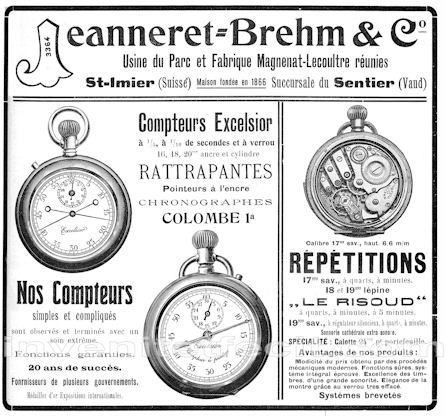
Advertisement of 1911
In 1915 the Excelsior trademark is also used for the repeating watches and in1918 the company becomes Les Fils de Jeanneret-Brehm, Excelsior Park. The name Speedway Watch Co. is sometimes added on the patents.
At the beginning of the years 1920, with the disaffection of the repeating watches, Excelsior Park will concentrate exclusively on the stopwatches and the chronographs. The Jeanneret-Brehm company indeed became Excelsior Park about 1918. It is directed by “Sirs R. - H and ED. Jeanneret. One of them, graduate of the Technicum of La Chaux-de-Fonds, is doubled of a sportsman specialist of races timing; often invited to function in the capacity as official time keeper, he was brought to build apparatuses which did not fail to be favorably accommodated everywhere. Most of them have been officially adopted by Swiss or international federations 1."
In 1921 a patent concerning a bolt placed on the middle, independent of the push-piece starting timing and allowing the stopping of the hand, is filed.
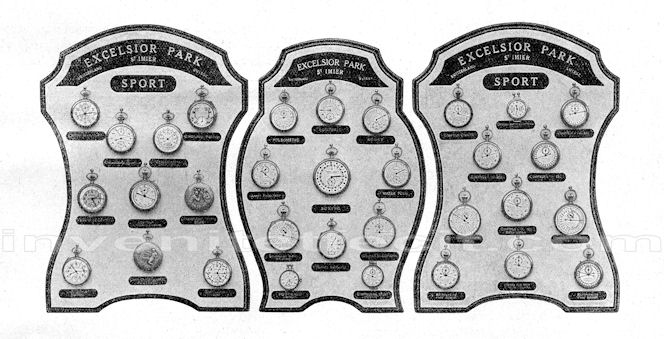
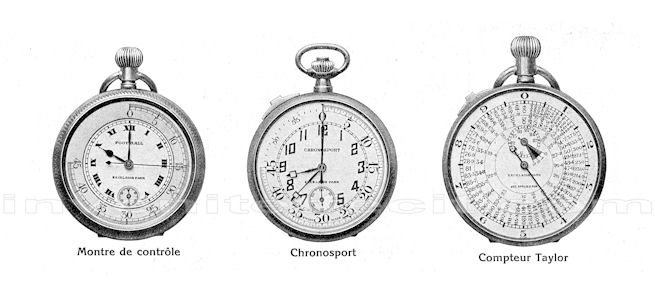
Examples of the chronographs and stop-watches from Excelsior Park in 1922
In 1922 Excelsior Parc has a range of 32 different stop-watches : tachymeters, pulsometers, with rattrapante, anchor or Roskopf, for football, rugby, water polo, hockey, with ringing for boxing, others for control with revolving bezel what was original for the time, Taylor meter for calculations of production, or the Electro-pointer built in collaboration with M.Chaponnière, official time keeper of the Car-Club of Switzerland.
This same year, on May 24th to be precise, Excelsior Park patents a small housing inside a movement to place spare parts. That will become also a kind of trademark, making possible instantaneously to recognize an Excelsior Park movement. This idea however will be copied, by Léonidas and Berna in particular, and Excelsior Park had to take advantage of its rights by way of press.
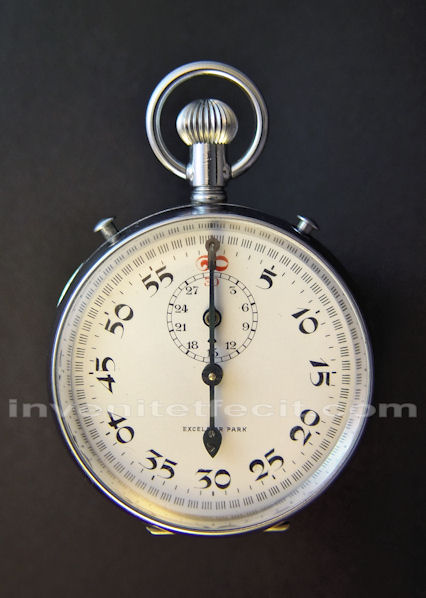




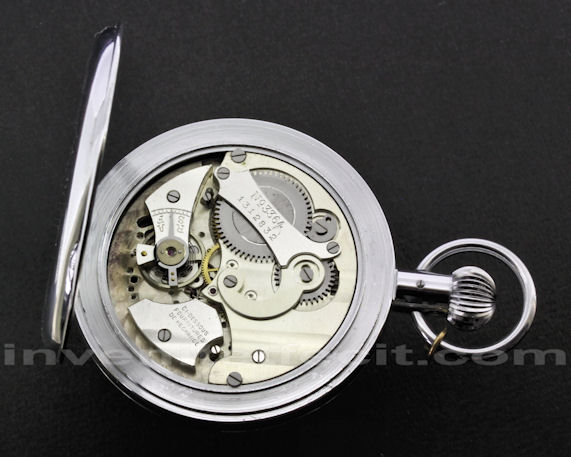
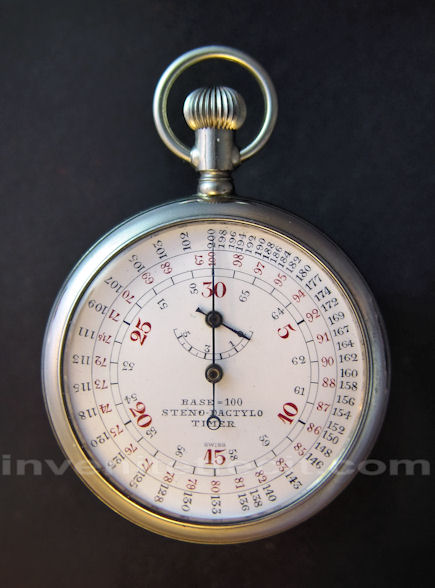
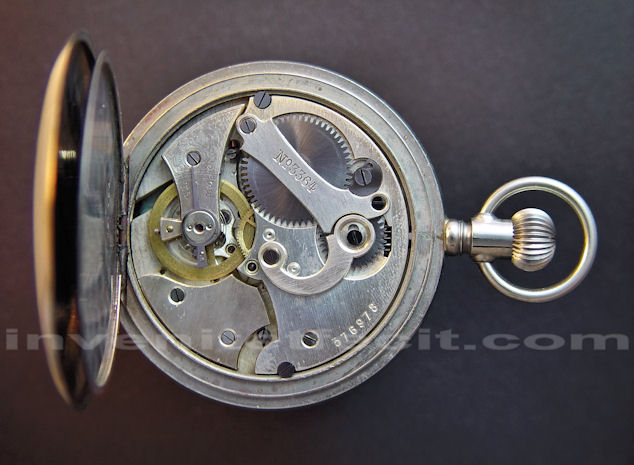

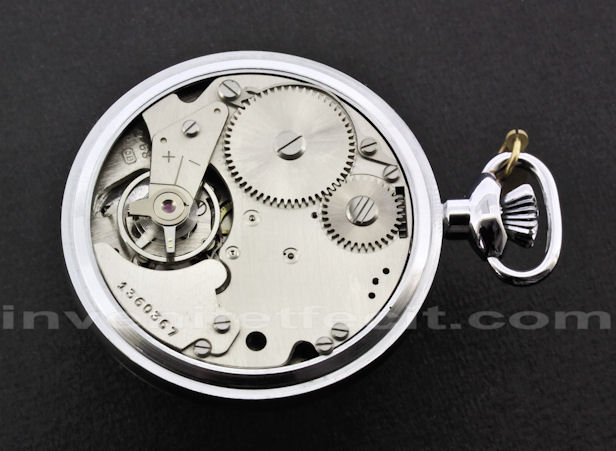

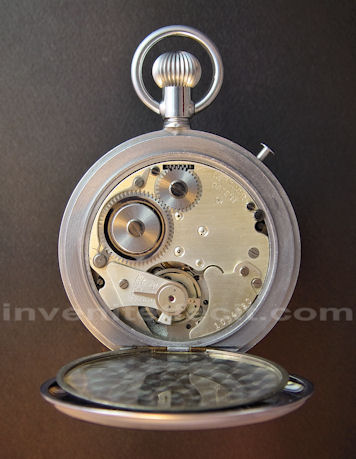
Examples of Excelsior Park stop-watches: inking, for football, for the rowing, steno, regattas and boxing
In 1928 Excelsior Park asserts the title of more important Swiss factory for sport stop-watches. The range still increased with stop-watches for canoeing, car sport, decimal timers, others measuring the hundredth of a second with the hand making a turn in one second. One year later is launched a series of new beautiful movements of chronograph, from 18 to 22 lines. They comprise supplies of spare parts for the repairing.
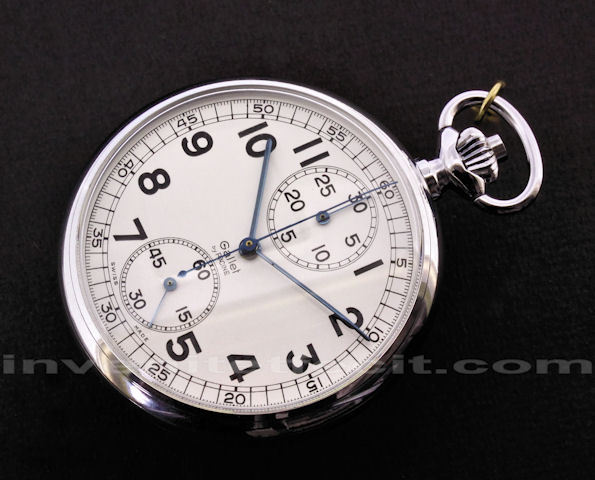

Chronograph Gallet equipped with the Excelsior Park caliber created in 1929
A turning occurs in 1938 with the creation of the shaped chronograph calibre 12/13 lines intended for the wrist watches. It is a beautiful movement which, with its alternatives, will be manufactured during nearly 40 years. The shaped chronograph calibersz are far from numerous: it seems that he is there hardly but Landeron 11 of the beginning of the years 1930, a stop-watch from Invicta which goes back to 1932, and a rare rectangular Movado chronograph assembled in a Reverso case about 1939.

Advertisement of 1938
The movement will be initially called simply 12/13 then it will be baptized calibre 42. There exists from the start with 1 or 2 push-pieces and meters 30 or 45 minutes counters. Excelsior Park proposes it in a small elegant chronograph which has an additional characteristic thus described: “to facilitate the reading of the dial on this small chronograph, part of the scale meter was placed on the tilted apart of the bezel, below the glass. This patented invention allows moreover the transformation of a telemeter chronograph, for example, out of tachymeter or pulsometer, simply by changing the scale meter.”


Chronograph c.1938 equipped with the revolving bezel and calibre Excelsior Park 12/13 with scale under glass
A few years later appeared a more traditional version, round, of this movement, baptized calibre 4 and one version with hours counter of calibre 4, under denomination 40.
But if this movement had an important diffusion it is that it was not used only by Excelsior Park. Three other companies used it : Gallet, Zenith and Girard Perregaux.
Julien Gallet, originating in Geneva, moved to La Chaux-de-Fonds as of the years 1820. His son Leon takes the changing and purchases the Electa company in 1907. Electa initially manufactured its own movements of chronograph in the Factory of St Jean in Geneva, under the name Société d'Horlogerie de Genève, but had moved to La Chaux-de-Fonds in 1902. Gallet manufactured very early wrist-chronographs which could carry the Electa brand.
The sister of Leon, Amanda, had married Jules Racine who had settled in New York where it represented the Gallet brand
2.
The company Gallet & Co. will not be able to be raised of the difficulties of the First World War and will be liquidated in 1928, but not the American branch who will remain active throughout the 20th century.
It seems that as soon as it was available, the calibre Excelsior Park 42 was used by Gallet.


Chronograph Gallet, calibre Excelsior Park 40, c. 1950
In the years 1930, Zenith was one of the most important manufacture of Switzerland. At the 1936 Fair of Basle a commentator is filled with wonder: “its collections were with large complete, including all that can wish serious customers. Out of pocket and bracelets, the traditional forms and last creations were represented by a selected range, in yellow gold, or white gold or steel. The technical side of its production continues to be the subject of vigilant sounds which are worth with Zenith of continual successes at the Observatories of Neuchâtel and Kew-Teddington. At the contest of the Observatory of Neuchâtel, in 1935, Zenith again placed heading - for the tenth time - allocating the 1st price of series for the six best pocket and ship's chronometers. The Zenith exhibition included moreover a choice of travelling clocks and alarm clocks, electric clocks, as well as a splendid series of "neuchâteloises" clocks 3."
But among all these models, not of chronograph. At this point in time Zenith turns to Excelsior Park and in 1938 launches its first wrist-chronographs, provided with the caliber EP 42.

Advertisement of 1938
Why Excelsior Park rather than Valjoux or Ebauches SA? There is certainly the will to remain independent of the trust but there are also qualities of the finished product thus described in publicities of the time: only one calibre 12-13"', therefore set of supply reduced, diameter of bezel 28mm, dials interchangeable, cases with the modern lines, extraordinary movement of quality and reasonable price.
During nearly 30 years Zenith will remain indeed faithful to the Excelsior Park chronographs calibres.

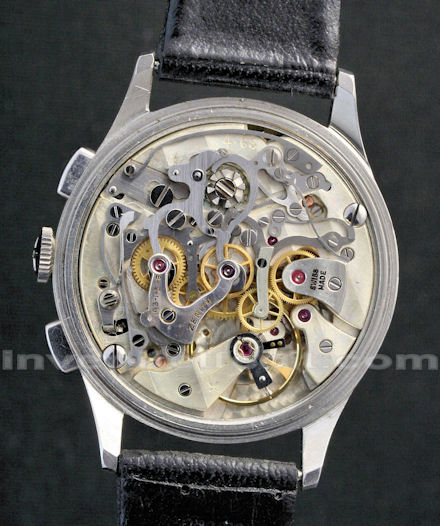
Chronograph Zenith, c. 1940, equipped with the Excelsior Park 4 calibre
Girard-Perregaux has been took over by Mimo in 1930. Mimo did not have chronograph calibre, if one excludes the Stop-in-flight caliber of the Mimolympic model of1936. It is probably to remain independent of Ebauches SA that the Excelsior Park caliber was selected for the signed chronographs Girard-Perregaux.
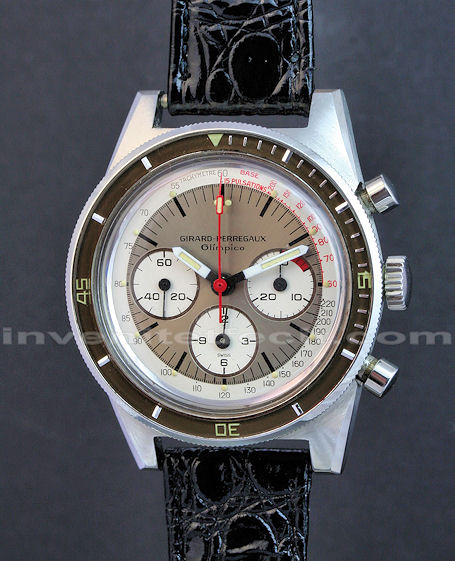
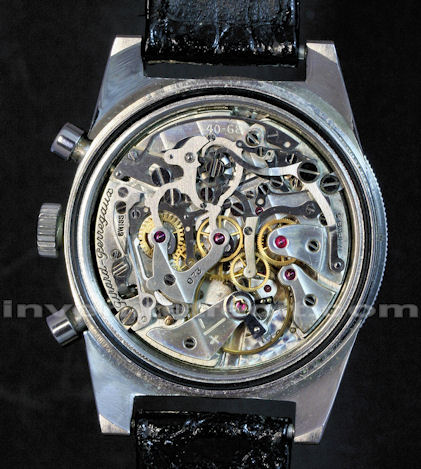
Girard-Perregaux chronograph, c. 1960, equipped with the Excelsior Park 40 calibre
On the basis of calibre 4, Excelsior Park will launch about 1945 one surprising chronograph with a hand of orientation: “This chronograph with double push-piece is provided with an hand in a shape of an arrow, turning in the center of the dial. This red hand carries the letter NR. It carries out a turn of the dial in 24 hours. To be oriented, it is enough, holding the horizontal watch, to make it turn until the hand of the hours “aims” the sun. The hand of orientation indicates the direction of north then. When after having let the watch stop, one gives the time, the hand of the hours must be superimposed on the hand of orientation at midnight and not noon. In this watch, a special device makes it possible to give the exact hour the small hand of the seconds. It is indeed enough to press, then to make turn a crown placed on the circumference of the case, opposite nine hours, to move the small second, in a direction or the other 4."

Chronograph with orientation hand, c. 1945
This device, whose patent was filed by the manufacture of St Imier in 1943, allowed a setting per hour “at the second”, the signal of a radiophonic signal for example, and authorized Excelsior Park a few years later, when the movement was provided with a shock-proof system, to recommend this watch to the military parachutists: “On the aircraft which transports them, the parachutists receive by radio the exact hour at the favorable time. Each one then puts its chronograph on time within 1 second, by moving the small hand of second of the quantity wanted by the means of the crown B. So after parachuting, it is so to speak to 1 second close, that all the men can approach in team at the prescribed hours, the various tasks which are entrusted to them. By starting the hands of the chronograph by the means of one of the two push-pieces, it is then permissible for them to measure the duration of the various phases of each military operation. To join the remote base of gathering then, in often unknown ground, the parachutist dissimulated in the ground is still directed thanks to another device of this clever watch. For that, it is enough for him to turn the watch in such way that the usual hand of hours aims at the position of the sun, then the additional central hand carrying the letter NR indicates the direction of North automatically to him 5."
This chronograph was also marketed by Gallet and Zenith which had baptized it Sextant.

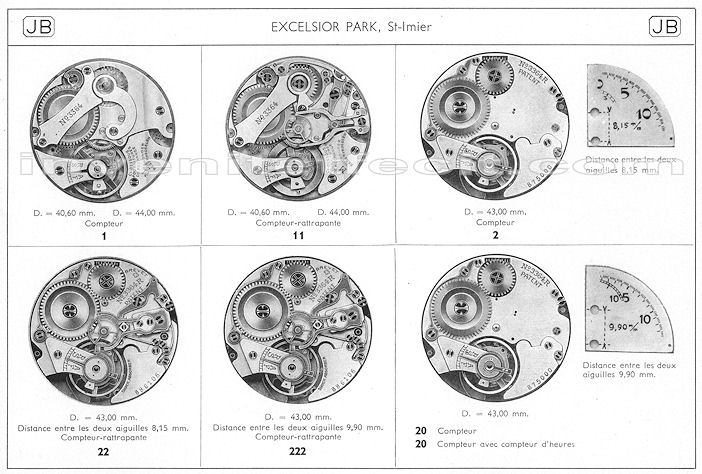
The main Excelsior Park calibres in 1949
Excelsior Park will continue the manufacture of chronographs and stop-watches until the years 1970 with always at its head a descendant of the founders. Some interesting models will make their appearance in the range: a Yachting model about 1964 with a moving backward minutes counter for the departure of the regattas, a diver model with a revolving bezel shortly after, and especially the Excel-O-Graph, chronograph provided with a bezel rule slide, in the great tradition of Mimo Loga and other Breitling Chronomat.

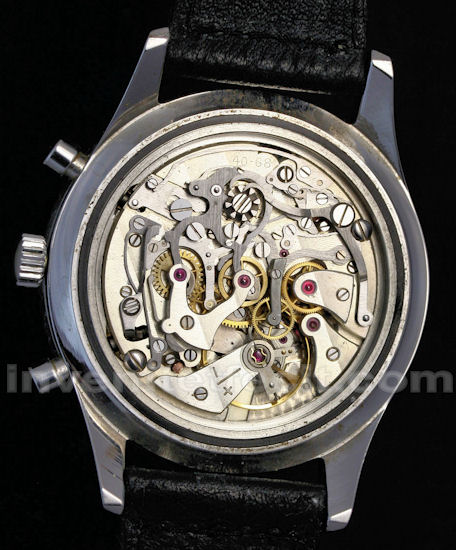
Excel-O-Graph chronograph, C. 1960, calibre Excelsior 40
On the stop-watch side, it is necessary to announce an interesting version with central minute and eccentric counter of hours presented at the Swiss National Exhibition in 1964.

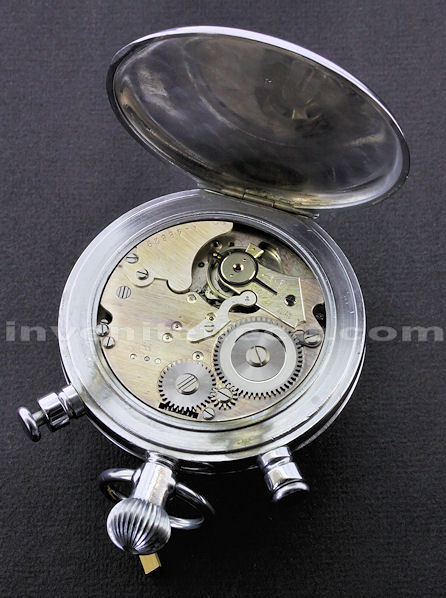
Stop-watch Excelsior Park decimal with decentered hours and minutes, presented at the Swiss National Exhibition in 1964
Excelsior Park will not resist the terrible crisis of the years 1970 and disappeared in 1984. A recovery was tried by the Fume company in Germany and many models of chronographs were launched, in particular the Monte Carlo model equipped with the rare calibre Valjoux 7740, manual version of the chronomatic, automatic chronograph movement developed by Buren and Dubois-Dépraz and launched in 1969 by Hamilton, Heuer and Breitling. This recovery was unfortunately of short duration.
But with a so prestigious past, perhaps that this trademark is in fact only in sleep...

Advertisement of 1969
Thanks: this article profited from the advised councils of Sebastien Chaulmontet. For the illustrations, thanks particular to Sebastien Chaulmontet, Edi Zumbach, Klaus Zimmermann, Gerd-R. Lang, Christian Pfeiffer-Belli and Antoine Simonin. The majority of the documents were consulted at the Musée International d'Horlogerie of La Chaux-de-Fonds. Thanks particular to Jean-Michel Piguet for its assistance concerning the iconography at the MIH.
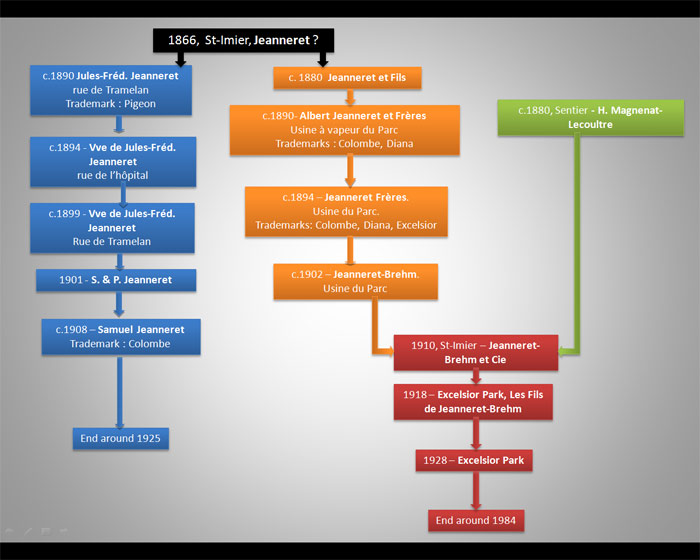
- Revue Internationale de l'Horlogerie et des Branches Annexes, 1922, p. 345-346
- Pierre-Yves Donzé, Les patrons horlogers de La-Chaux-de-Fonds, Editions Alphil, 2007, p.32
- Revue Internationale de l'Horlogerie, 1936, p.108
- Le chronographe avec aiguille d'orientation, La Suisse Horlogère, 1953, p.16
- Revue Internationale d'Horlogerie, 1954, p. 26
|